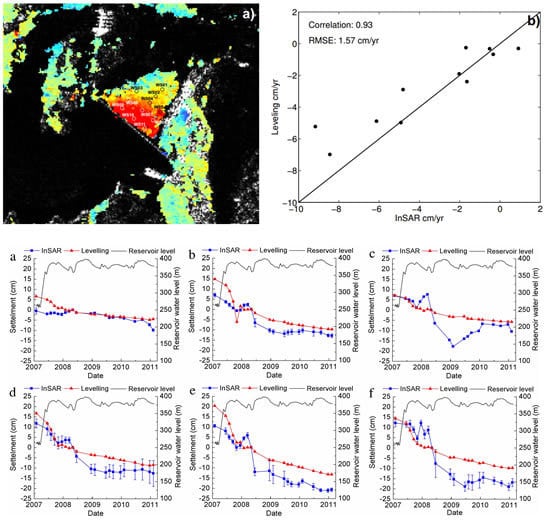Remote Sensing of Deformation of a High Concrete-Faced Rockfill Dam Using InSAR: A Study of the Shuibuya Dam, China
Abstract
:1. Introduction
2. Study Area and Dataset
2.1. Study Area
2.1.1. Geological Setting of the Shuibuya CFRD
2.1.2. The Shuibuya CFRD
2.2. Ground Data
2.2.1. Ground Monitoring System
2.2.2. Ground Monitoring Results
- The period of dam construction (before October 2006).
- The period during the first reservoir filling (October 2006–September 2007, when the water level was between 205.06 m above sea level and 389.61 m).
- The period of operation (September 2007–January 2014, when the water level was between 359.68 m and 398.56 m).
2.3. SAR Data
3. Advanced InSAR Analysis
Time Series Analysis
4. Results
4.1. Mean Velocity and Validation
4.2. Time Series Analysis
5. Discussions
6. Conclusions
Acknowledgments
Author Contributions
Conflicts of Interest
References
- Hunter, G.; Fell, R. Rockfill modulus and settlement of concrete face rockfill dams. J. Geotech. Geoenviron. Eng. 2003, 129, 909–917. [Google Scholar] [CrossRef]
- Zhou, W.; Hua, J.; Chang, X.; Zhou, C. Settlement analysis of the shuibuya concrete-face rockfill dam. Comput. Geotech. 2011, 38, 269–280. [Google Scholar] [CrossRef]
- Zhou, W.; Chang, X.; Zhou, C.; Liu, X. Creep analysis of high concrete-faced rockfill dam. Int. J. Numer. Methods Biomed. Eng. 2010, 26, 1477–1492. [Google Scholar]
- Yang, Z.Y.; Jiang, G.C. Deformation control techniques for 200 m-high hongjiadu concrete face rockfill dam. Chin. J. Geotech. Eng. 2008, 30, 1241–1247. [Google Scholar]
- Li, Z.; Li, J.; Zheng, S.; Wu, Q. Several measures for improving hydraulic overflow settlement gauge. Hydropower Autom. Dam Monit. 2010, 6, 31–33. [Google Scholar]
- Han, J.; Zhang, C. Experimental research on the installation of pipe-type settlement gauge in Nuozhadu hydropower station. Water Power 2012, 9, 64–67. [Google Scholar]
- Liu, G.; Li, Z.; Li, X.; Wang, J. Experimental analysis of horizontal displacement monitoring device with long pipeline tensile. Hydropower Autom. Dam Monit. 2012, 36, 53–56. [Google Scholar]
- Peng, H. Interior deformation monitoring of dam body for 300 m high grade cfrd. Hydropower Autom. Dam Monit. 2012, 36, 40–44. [Google Scholar]
- Massonnet, D.; Feigl, K.L. Radar interferometry and its application to changes in the earth’s surface. Rev. Geophys. 1998, 36, 441–500. [Google Scholar] [CrossRef]
- Simons, M.; Rosen, P.A. Interferometric synthetic aperture radar geodesy. In Treatise on Geophysics; Gerald, S., Ed.; Elsevier: Amsterdam, The Netherlands, 2007; pp. 391–446. [Google Scholar]
- Rosen, P.A.; Hensley, S.; Joughin, I.R.; Li, F.K.; Madsen, S.N.; Rodriguez, E.; Goldstein, R.M. Synthetic aperture radar interferometry. Proc. IEEE 2000, 88, 333–382. [Google Scholar] [CrossRef]
- Di Martire, D.; Iglesias, R.; Monells, D.; Centolanza, G.; Sica, S.; Ramondini, M.; Pagano, L.; Mallorquí, J.J.; Calcaterra, D. Comparison between differential sar interferometry and ground measurements data in the displacement monitoring of the earth-dam of conza della campania (Italy). Remote Sens. Environ. 2014, 148, 58–69. [Google Scholar] [CrossRef]
- Wang, T.; Perissin, D.; Rocca, F.; Liao, M.-S. Three gorges dam stability monitoring with time-series InSAR image analysis. Sci. China Earth Sci. 2011, 54, 720–732. [Google Scholar] [CrossRef]
- Lazecký, M.; Perissin, D.; Zhiying, W.; Ling, L.; Yuxiao, Q. Observing dam’s movements with spaceborne sar interferometry. In Engineering Geology for Society and Territory—Volume 5; Lollino, G., Manconi, A., Guzzetti, F., Culshaw, M., Bobrowsky, P., Luino, F., Eds.; Springer International Publishing: Cham, Switzerland, 2015; pp. 131–136. [Google Scholar]
- Voege, M.; Frauenfelder, R.; Larsen, Y. Displacement monitoring at svartevatn dam with interferometric sar. In Proceedings of the 2012 IEEE International Geoscience and Remote Sensing Symposium (IGARSS), Munich, Germany, 22–27 July 2012; pp. 3895–3898.
- Xu, W.; Xie, S.; Xu, R.; Liu, S.; Zhu, Z. Gological model for rockmass of dam foundation at shuibuya hydropower station. J. Eng. Geol. 2002, 10, 260–265. [Google Scholar]
- Hu, D.; Shi, L.; Tan, C. 3-d umerical simulation on rock stability of shuibuya hydroelectrical project on the qingjiang river. Geoscience 1999, 4, 466–470. [Google Scholar]
- Farr, T.G.; Rosen, P.A.; Caro, E.; Crippen, R.; Duren, R.; Hensley, S.; Kobrick, M.; Paller, M.; Rodriguez, E.; Roth, L.; et al. The shuttle radar topography mission. Rev. Geophys. 2007, 45, RG2004. [Google Scholar] [CrossRef]
- Eineder, M.; Hubig, M.; Milcke, B. Unwrapping large interferograms using the minimum cost flow algorithm. In Proceedings of the 1998 IEEE International Geoscience and Remote Sensing Symposium, IGARSS’98, Seattle, WA, USA, 6–10 July 1998; pp. 83–87.
- Hanssen, R.F. Radar Interferometry: Data Interpretation and Error Analysis; Springer Science & Business Media: Dordrecht, The Netherland, 2001. [Google Scholar]
- Ferretti, A.; Prati, C.; Rocca, F. Permanent scatterers in SAR interferometry. IEEE Trans. Geosci. Remote Sens. 2001, 39, 8–20. [Google Scholar] [CrossRef]
- Berardino, P.; Fornaro, G.; Lanari, R.; Sansosti, E. A new algorithm for surface deformation monitoring based on small baseline differential SAR interferograms. IEEE Trans. Geosci. Remote Sens. 2002, 40, 2375–2383. [Google Scholar] [CrossRef]
- Hooper, A.; Segall, P.; Zebker, H. Persistent scatterer interferometric synthetic aperture radar for crustal deformation analysis, with application to volcán alcedo, galápagos. J. Geophys. Res. 2007, 112, B07407. [Google Scholar] [CrossRef]
- Doin, M.-P.; Guillaso, S.; Jolivet, R.; Lasserre, C.; Lodge, F.; Ducret, G.; Grandin, R. Presentation of the small-baseline nsbas processing chain on a case example: The etna deformation monitoring from 2003 to 2010 using Envisat data. In Proceddings of the Fringe 2011 Workshop, Frascati, Italy, 19–23 September 2011; pp. 303–304.
- Ferretti, A.; Fumagalli, A.; Novali, F.; Prati, C.; Rocca, F.; Rucci, A. A new algorithm for processing interferometric data-stacks: Squeesar. IEEE Trans. Geosci. Remote Sens. 2011, 49, 1–11. [Google Scholar] [CrossRef]
- Li, Z.; Fielding, E.J.; Cross, P. Integration of InSAR time-series analysis and water-vapor correction for mapping postseismic motion after the 2003 bam (Iran) earthquake. IEEE Trans. Geosci. Remote Sens. 2009, 47, 3220–3230. [Google Scholar]
- Zhang, L.; Ding, X.; Lu, Z. Ground settlement monitoring based on temporarily coherent points between two sar acquisitions. ISPRS J. Photogramm. Remote Sens. 2011, 66, 146–152. [Google Scholar] [CrossRef]
- Sowter, A.; Bateson, L.; Strange, P.; Ambrose, K.; Syafiudin, M.F. Dinsar estimation of land motion using intermittent coherence with application to the south derbyshire and leicestershire coalfields. Remote Sens. Lett. 2013, 4, 979–987. [Google Scholar] [CrossRef]
- Hanssen, R.F. Radar Interferometry: Data Interpretation and Error Analysis; Kluwer Academic Plublishers: Dordrecht, The Netherlands, 2001. [Google Scholar]
- Li, Z.; Fielding, E.J.; Cross, P.; Muller, J.-P. Interferometric synthetic aperture radar atmospheric correction: GPS topography-dependent turbulence model. J. Geophys. Res. Solid Earth 2006, 111, B02404. [Google Scholar] [CrossRef]
- Williams, S.; Bock, Y.; Fang, P. Integrated satellite interferometry: Tropospheric noise, GPS estimates and implications for interferometric synthetic aperture radar products. J. Geophys. Res. Solid Earth 1998, 103, 27051–27067. [Google Scholar] [CrossRef]
- Hammond, W.C.; Blewitt, G.; Li, Z.; Plag, H.P.; Kreemer, C. Contemporary uplift of the sierra nevada, western united states, from GPS and InSAR measurements. Geology 2012, 40, 667–670. [Google Scholar] [CrossRef]
- Li, Z.; Muller, J.-P.; Cross, P.; Fielding, E.J. Interferometric synthetic aperture radar (InSAR) atmospheric correction: GPS, moderate resolution imaging spectroradiometer (MODIS), and InSAR integration. J. Geophys. Res. 2005, 110, B03410. [Google Scholar] [CrossRef]
- Li, Z.; Fielding, E.J.; Cross, P.; Muller, J.-P. Interferometric synthetic aperture radar atmospheric correction: Medium resolution imaging spectrometer and advanced synthetic aperture radar integration. Geophys. Res. Lett. 2006, 33, L06816. [Google Scholar] [CrossRef]
- Li, Z.; Fielding, E.J.; Cross, P.; Preusker, R. Advanced InSAR atmospheric correction: Meris/MODIS combination and stacked water vapour models. Int. J. Remote Sens. 2009, 30, 3343–3363. [Google Scholar] [CrossRef]
- Jolivet, R.; Agram, P.S.; Lin, N.Y.; Simons, M.; Doin, M.-P.; Peltzer, G.; Li, Z. Improving InSAR geodesy using global atmospheric models. J. Geophys. Res. Solid Earth 2014, 119, 2324–2341. [Google Scholar] [CrossRef]
- Talich, M.; Glöckner, M.; Böhm, O.; Antoš, F.; Soukup, L.; Havrlant, J.; Šolc, J. The application of the ground-based InSAR technique for the deformation monitoring of concrete hydropower dam orlík on vltava river. In Proceedings of the 6th International Conference on Engineering Surveying, Prague, Czech Republic, 3 April 2014.
- Monserrat, O.; Crosetto, M.; Luzi, G. A review of ground-based SAR interferometry for deformation measurement. ISPRS J. Photogramm. Remote Sens. 2014, 93, 40–48. [Google Scholar] [CrossRef]
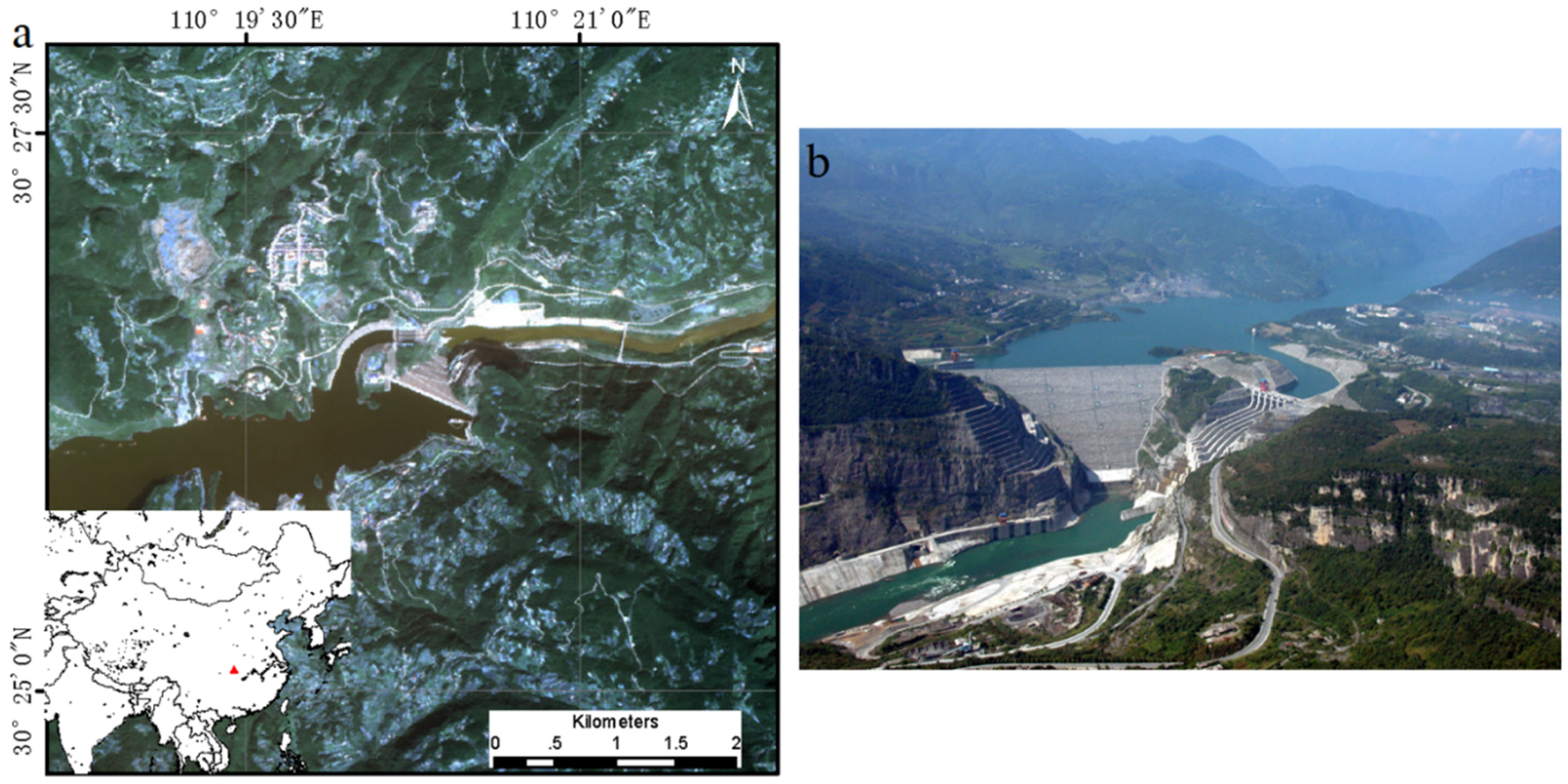
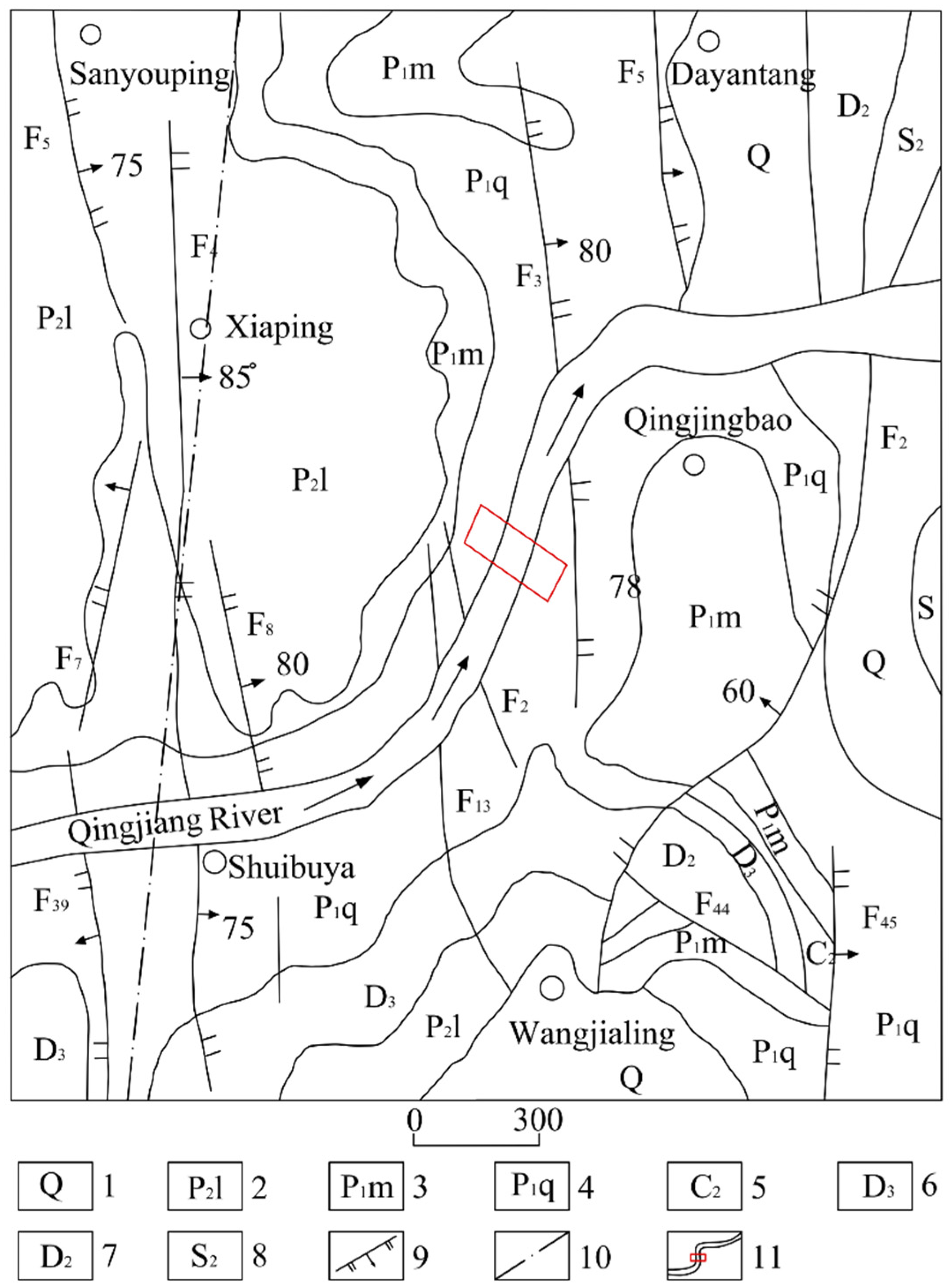
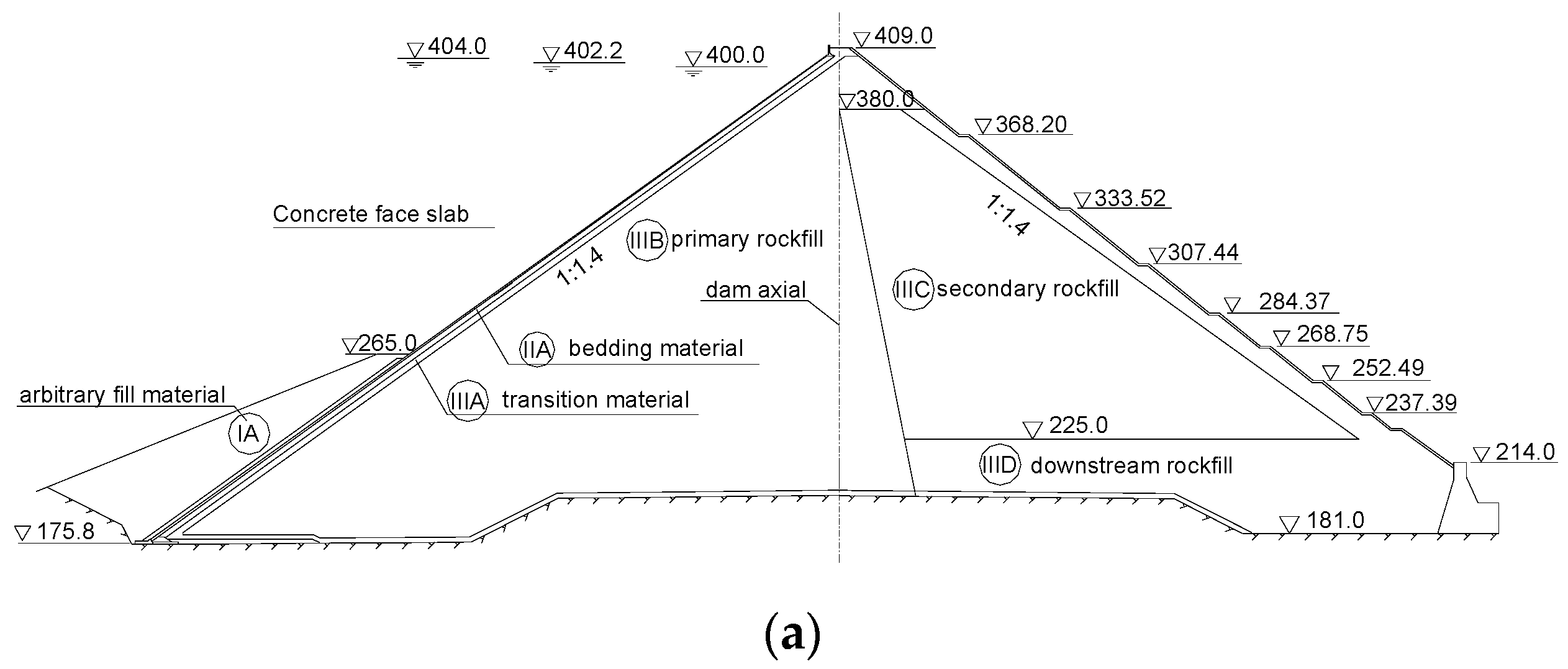
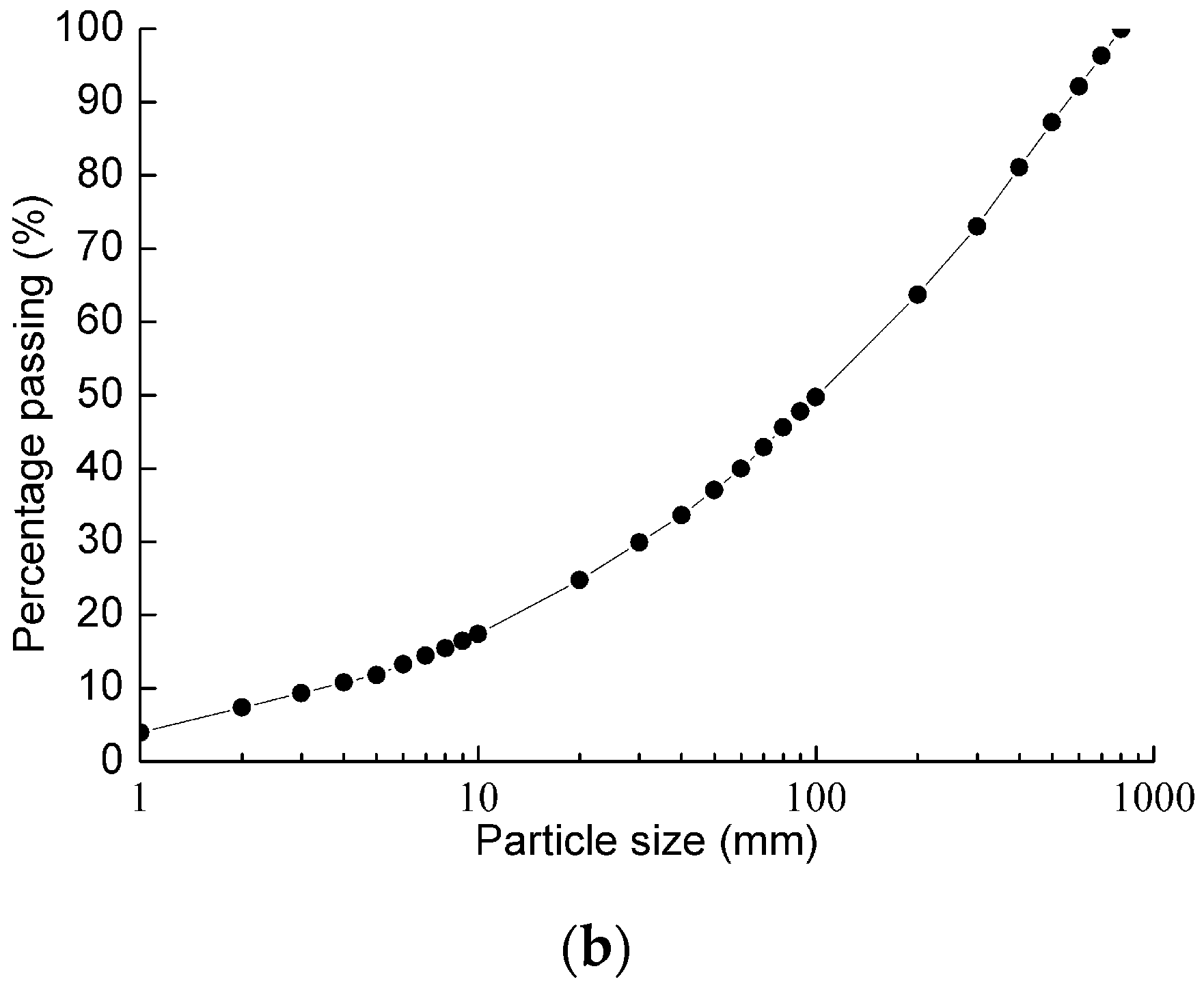

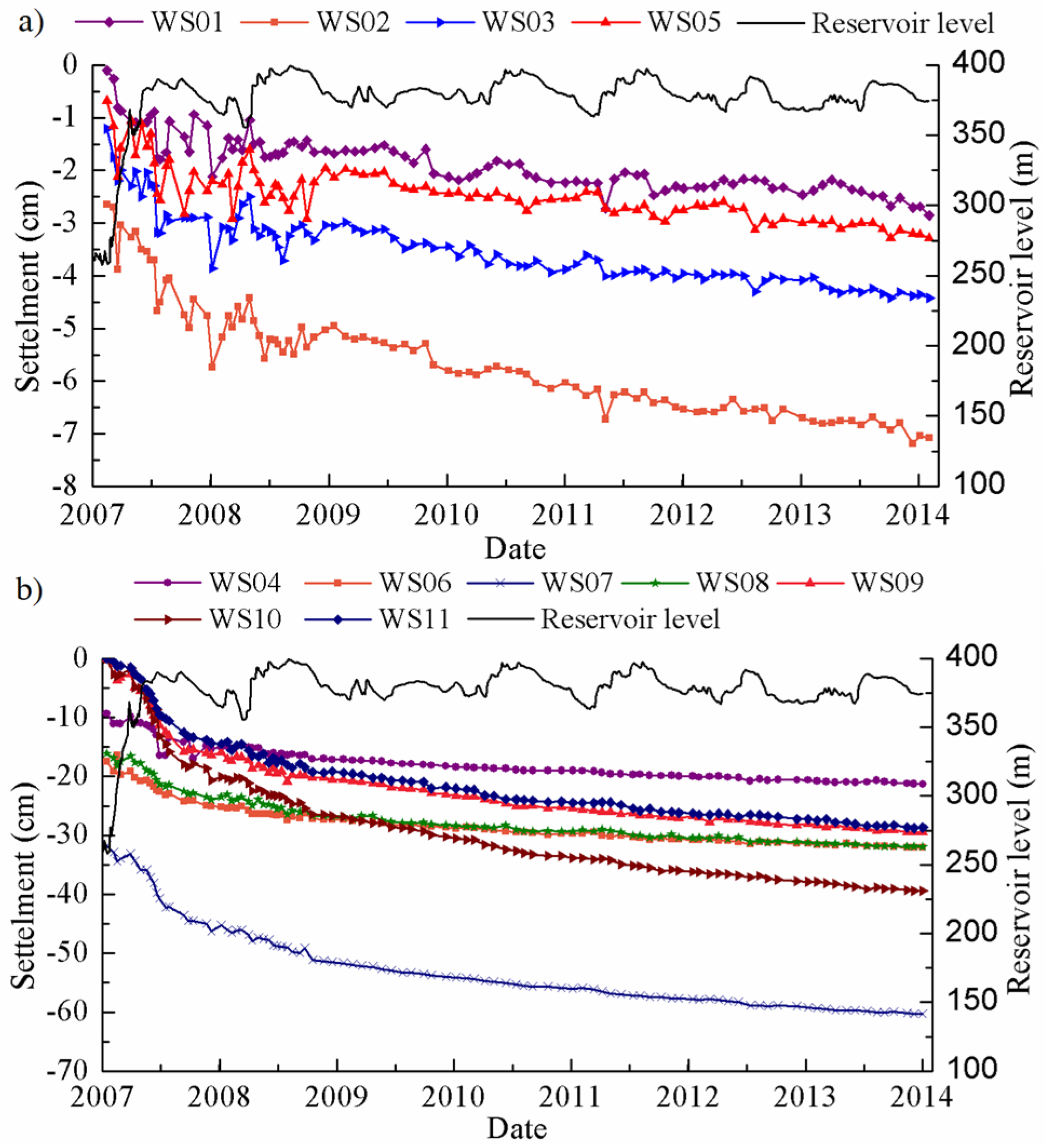
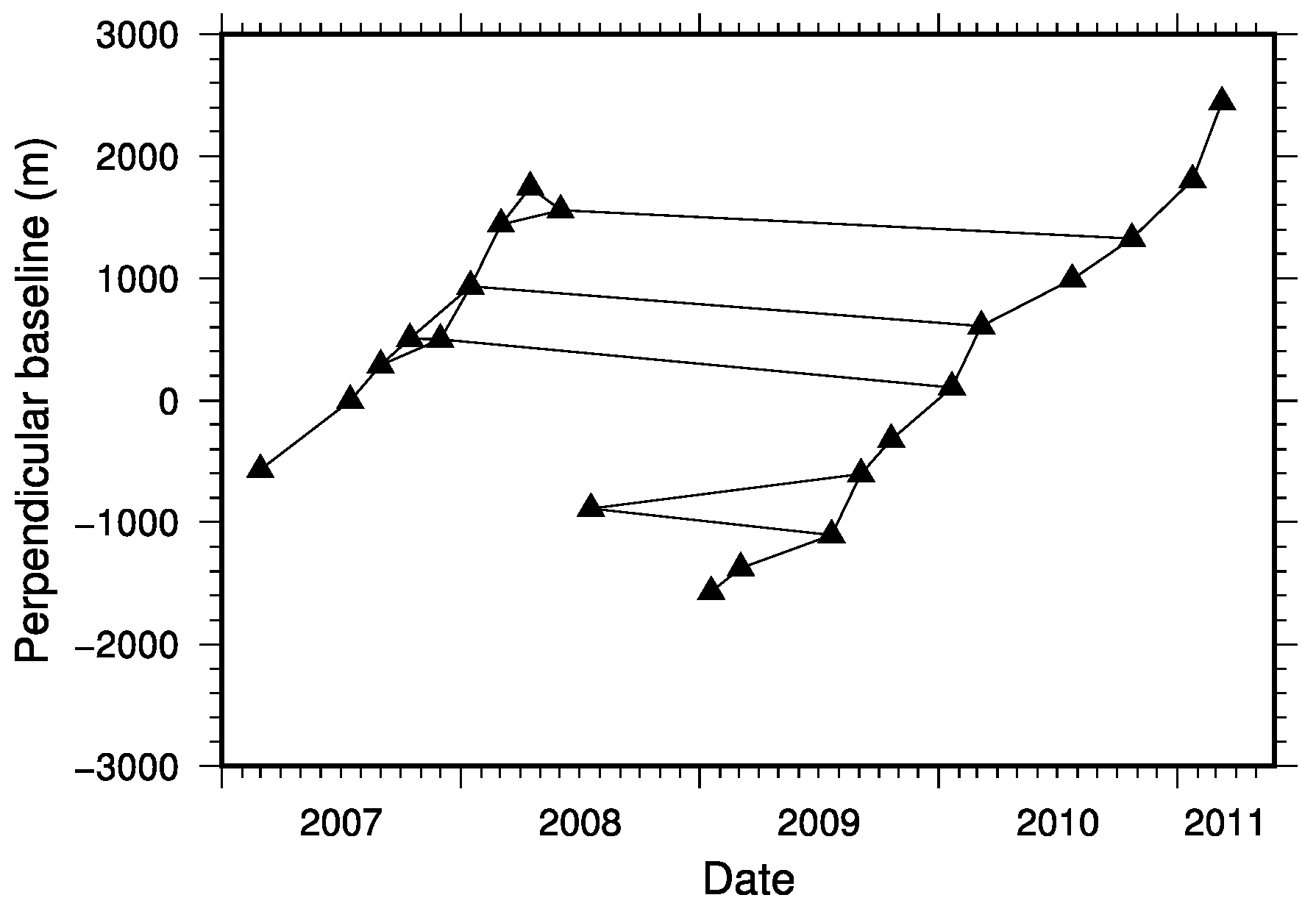
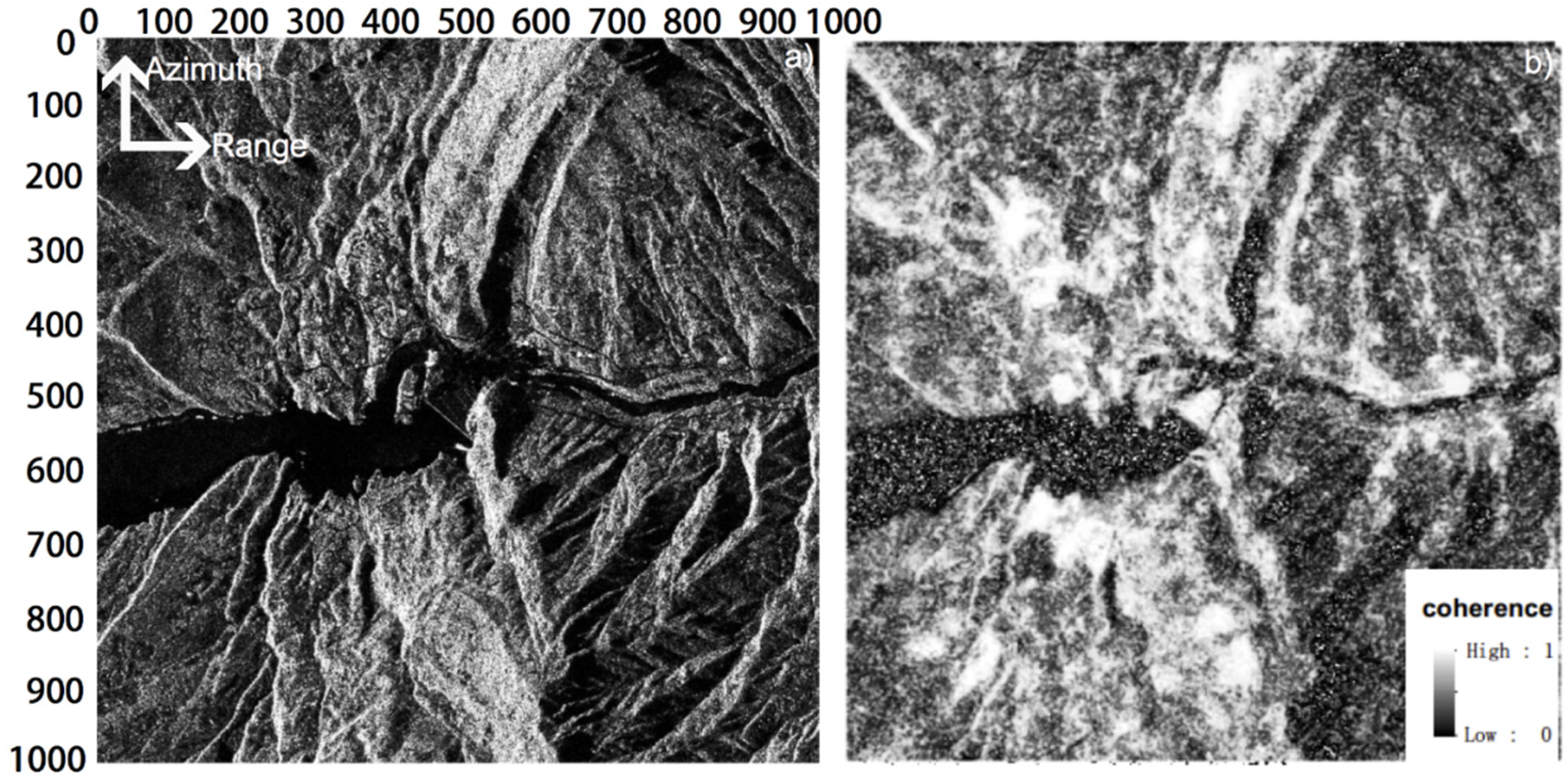
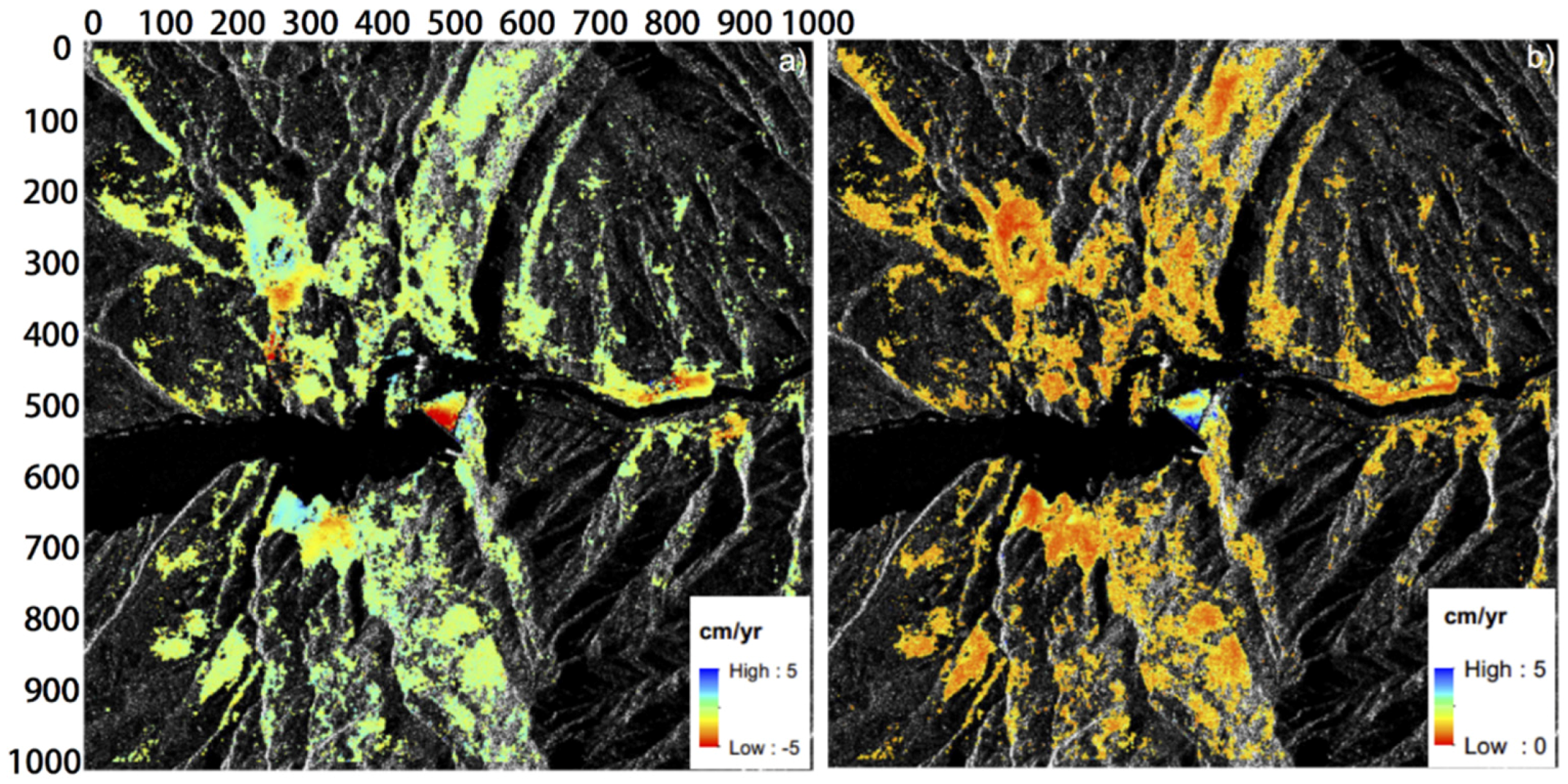
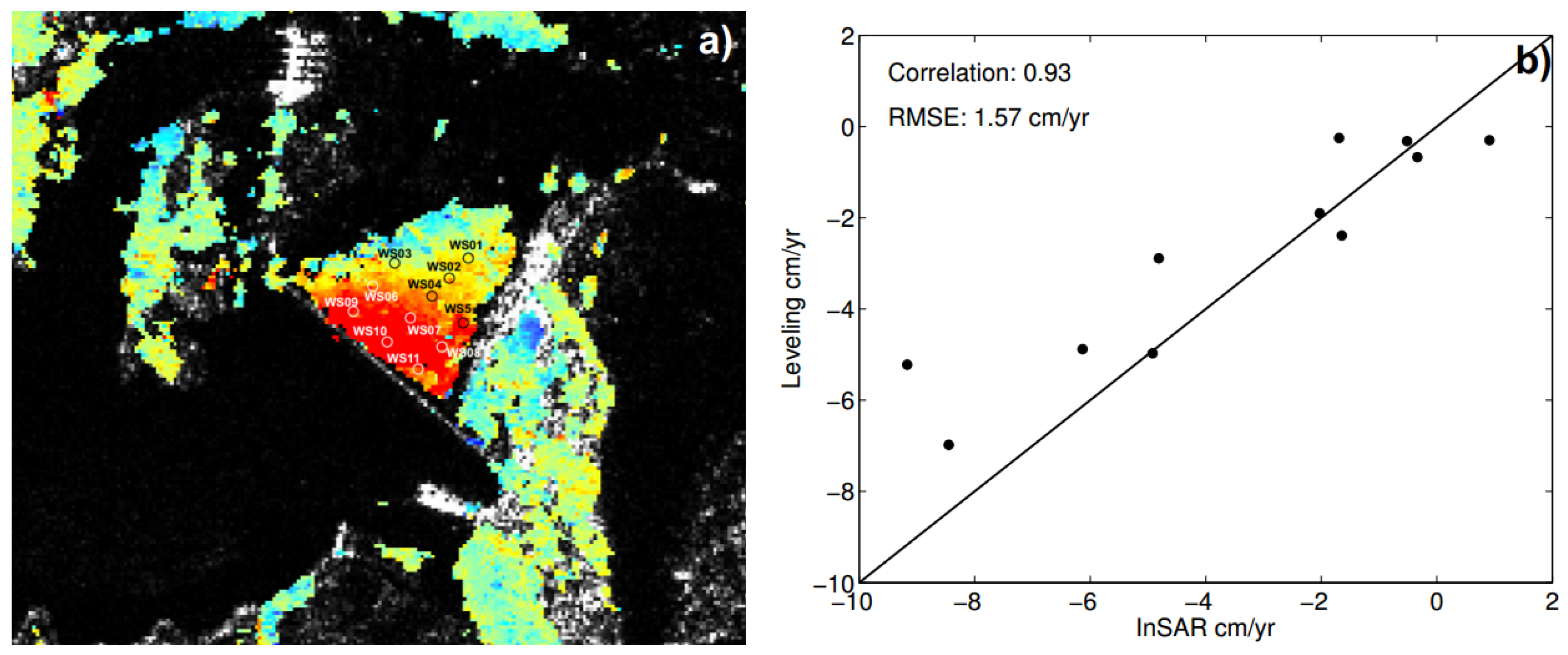
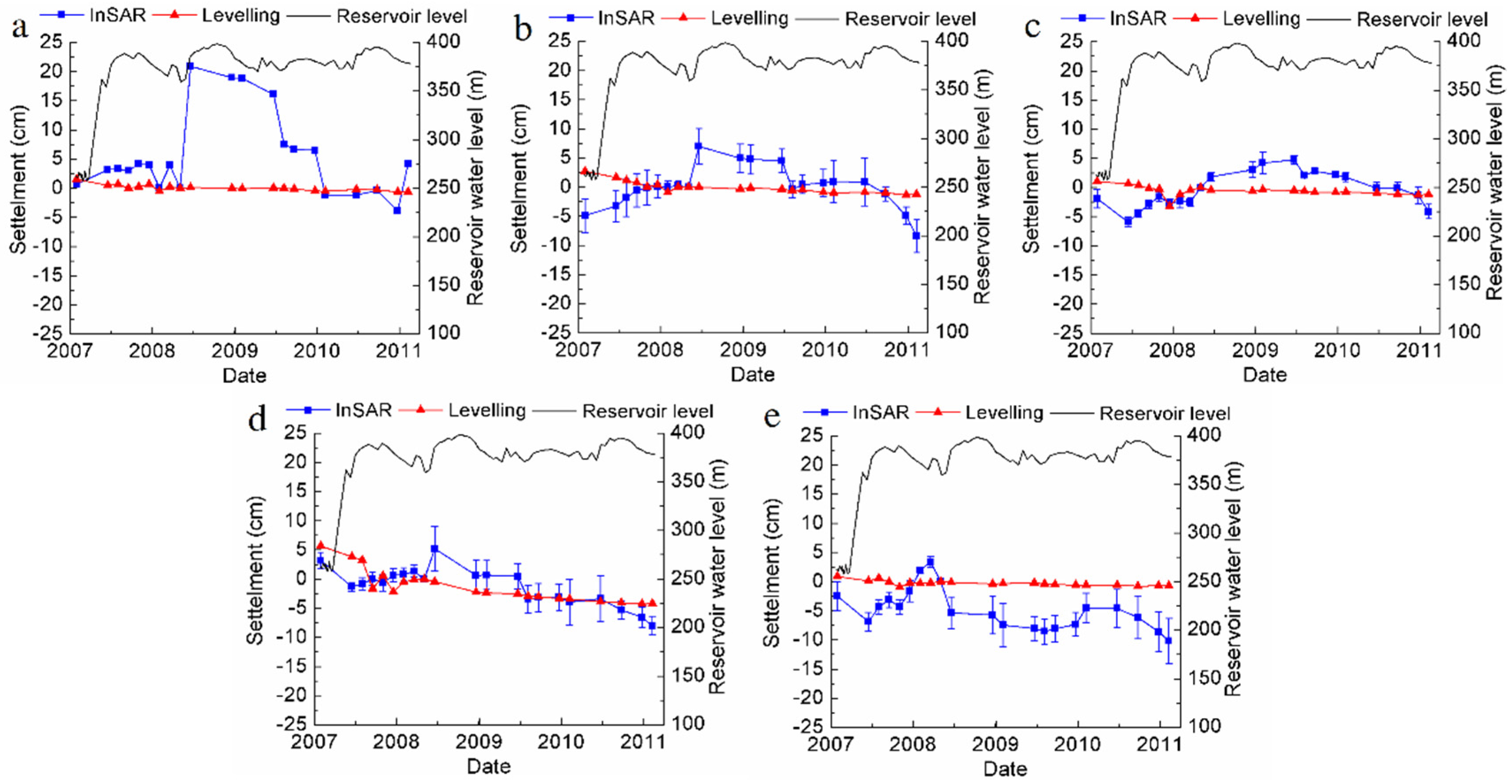
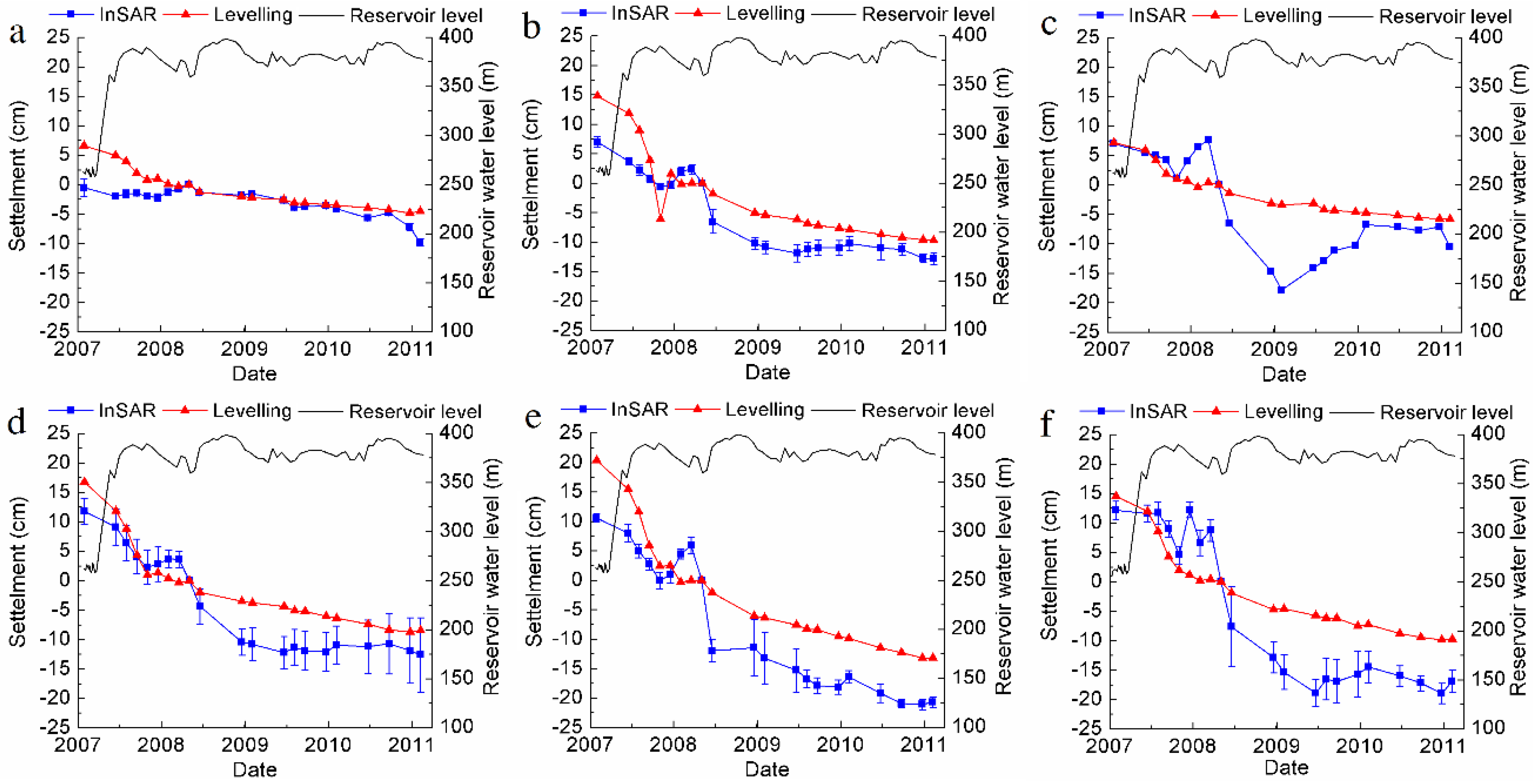
| WS01 | WS02 | WS03 | WS04 | WS05 | WS06 | WS07 | WS08 | WS09 | WS10 | WS11 | |
|---|---|---|---|---|---|---|---|---|---|---|---|
| X (m) | 265.0 | 214.0 | 161.0 | 161.0 | 161.0 | 108.0 | 108.0 | 108.0 | 48.0 | 48.0 | 48.0 |
| Y (m) | 256.8 | 252.0 | 132.0 | 247.2 | 357.6 | 132.0 | 240.0 | 357.6 | 132.0 | 237.6 | 357.6 |
| Z (m) | 235.0 | 265.0 | 300.0 | 300.0 | 300.0 | 340.0 | 340.0 | 340.0 | 370.0 | 370.0 | 370.0 |
| νSAR (cm/year) | νWS (cm/year) | Difference (cm/year) | |
|---|---|---|---|
| WS01-SAR1 | −0.52 | −0.32 | 0.20 |
| WS02-SAR2 | −0.34 | −0.67 | 0.33 |
| WS03-SAR3 | 0.91 | −0.30 | 1.21 |
| WS04-SAR4 | −2.03 | −1.90 | 0.13 |
| WS05-SAR5 | −1.69 | −0.25 | 1.44 |
| WS06-SAR6 | −1.64 | −2.39 | 0.75 |
| WS07-SAR7 | −4.92 | −4.97 | 0.05 |
| WS08-SAR8 | −4.81 | −2.89 | 1.92 |
| WS09-SAR9 | −6.13 | −4.88 | 1.25 |
| WS10-SAR10 | −8.45 | −6.98 | 1.47 |
| WS11-SAR11 | −9.17 | −5.22 | 3.95 |
© 2016 by the authors; licensee MDPI, Basel, Switzerland. This article is an open access article distributed under the terms and conditions of the Creative Commons by Attribution (CC-BY) license (http://creativecommons.org/licenses/by/4.0/).
Share and Cite
Zhou, W.; Li, S.; Zhou, Z.; Chang, X. Remote Sensing of Deformation of a High Concrete-Faced Rockfill Dam Using InSAR: A Study of the Shuibuya Dam, China. Remote Sens. 2016, 8, 255. https://doi.org/10.3390/rs8030255
Zhou W, Li S, Zhou Z, Chang X. Remote Sensing of Deformation of a High Concrete-Faced Rockfill Dam Using InSAR: A Study of the Shuibuya Dam, China. Remote Sensing. 2016; 8(3):255. https://doi.org/10.3390/rs8030255
Chicago/Turabian StyleZhou, Wei, Shaolin Li, Zhiwei Zhou, and Xiaolin Chang. 2016. "Remote Sensing of Deformation of a High Concrete-Faced Rockfill Dam Using InSAR: A Study of the Shuibuya Dam, China" Remote Sensing 8, no. 3: 255. https://doi.org/10.3390/rs8030255





